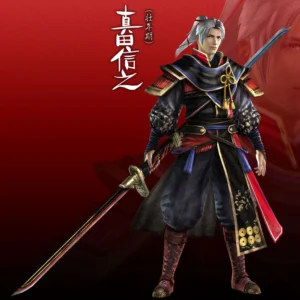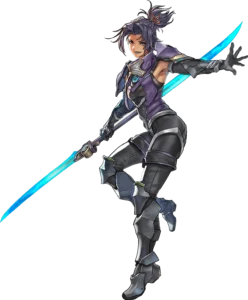Swords are cool. Do you like swords? I like swords. I think they look neat, I think they can do cool stuff, and there are a bunch of different varieties. They have different benefits and drawbacks, come from different time periods and cultures, and often end up emblematic of a certain aesthetic essence. The rapier is sleek, noble, and refined. The cutlass is a bit rougher around the edges, carried by pirates and swashbucklers. The longsword is the weapon of knights, and the katana is carried by samurai.
But, my friends, we are not here to talk about real or realistic weapons. We are here to talk about fantasy weapons, discuss ups and downs, and give them some (perhaps flimsy) justification. Today, we are here to talk about Twinblades.
 (Pictured: Nobuyuki Sanada from the Samurai Warriors Series)
(Pictured: Nobuyuki Sanada from the Samurai Warriors Series)

(Pictured: Ashera from Xenoblade Chronicles 3)
Twinblades are one of those funky kinds of weapons that have been ripped to shreds over the years online. They appear in fiction often enough, from video games to movies and even quite a few tabletop games (double bladed swords have been in Dungeons and Dragons for decades), but they don’t really pop up in real life. At least, not in the same way that we see them in fiction. Especially taking realism into account, they aren’t exactly the most convenient weapon. They’re hard to carry, edge alignment can be difficult, and standard sword methods aren’t easy to apply. However… they do look cool. So in what other ways can we justify their existence? How are they used, what benefits do they carry, and what could make them a preferably option in the right scenario?
First, let’s talk about one of the obvious benefits: More sword in your sword. More bang for your buck, more slice for your silver. If one end wears down or breaks, good news, you still have a perfectly good weapon. And, even if the first edge dulls, it’s still probably going to be good for stabbing with. In this article from The Journal of Forensic Sciences, they learned that the sharpness of the edge is less important than the sharpness of the tip when it comes to thrusting. This also plays into another benefit of twinblades, the fact that they frequently have longer handles than other swords, as they’re meant to be wielded in two hands. This, combined with the standard practices of wielding one, means that it can be used as a spear without too much trouble.
This leads nicely into the other benefit, versatility and misdirection in combat. From a “neutral” position, you’re given options for a cut or thrust. If you want to pull back, you have a second blade to threaten your enemy with. Also consider that, with a double-ended sword, you’re always “wound up” for a stronger attack, without necessarily sacrificing your defense. Even on a missed attack, following through with the motion can lead to a strike with the second blade. And perhaps a third strike, or a fourth, or a fifth… twinblades naturally lend themselves to spins and flourishes, while remaining deadly. An opponent trying to take advantage of a seemingly superfluous movement may find themselves bloodied.
Now, you could say the same for dual wielding two swords of similar length. They lend themselves to diversion and flourishes and continuous offensives. But dual wielding will be a post for another time. The advantage that a two bladed sword has here is leverage. Every strike can use the full speed and strength that both arms provide, where one handed weapons might be more limited in terms of force and maneuverability.
Now, stepping further into the realm of fantasy, we can talk about the benefits a twinblade might have when the supernatural is added to the mix. For example, weaknesses. Say that a monster slayer decides to carry a twinblade, but these creatures often have unique mystical properties. The fey can be harmed only by cold iron, werewolves are vulnerable to silver, or perhaps a beast in your own setting can only be harmed by some other special material. Nothing says that your blades need to be made of the same material as each other. One could be tried and true steel, while the other, on the “back” side, is cold iron with a more specific usage. Perhaps special runes are carved into the length of each blade, granting them different magical properties that would otherwise be incompatible. One blade carries an icy chill, while the other crackles with fire. No matter the encounter, your weapon is bound to do something to your adversary.
As an example of twinblade usage, I’d like to direct your attention to this video from The Great Orange, demonstrating the moveset of the twinblade weapon in Elden Ring. It shows off some of the benefits I’ve talked about, while also adding an additional one: Status Effects. In Elden Ring, you can apply special properties to your weapons that allow them to inflict different ailments on an opponent with repeated strikes. Rapid blood loss, poison, frostbite, and so on. Twinblades hit rapidly, making for a fast buildup of these effects. They also enjoy the benefit of only needing to upgrade and modify a single weapon, whereas dual wielding would have double the cost.
This has been all for now, but I’ll see you again soon. Hope you enjoyed!
